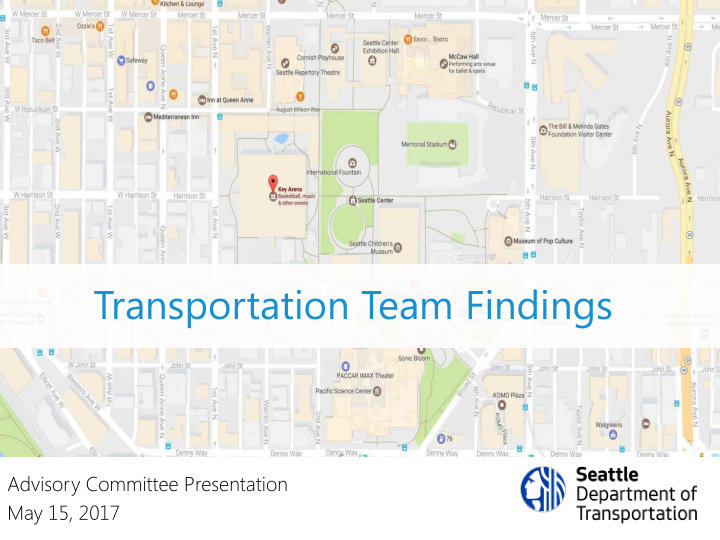



Transportation Team Findings Advisory Committee Presentation May 15, 2017
Agenda • Transportation review team members • Overview of Arena RFP - transportation • Oak View Group findings • Seattle Partners findings • Conclusions • Questions
Transportation review team • Seattle Center Staff: – Julia Levitt – Lance Miller • Seattle Department of Construction and Inspections (SDCI): – John Shaw • Office of Planning and Community Development (OPCD): – Jim Holmes • Seattle Department of Transportation (SDOT): – Kevin O’Neill (team lead) – Sara Zora • Office of Policy and Innovation (OPI): – Kevin Shively 3
Overview of Arena RFP – transportation 1. Provide safe and convenient access for all 2. Implement programs to reach mode share targets 3. Develop parking management strategies 4. Increase transit service 5. Leverage and integrate shared mobility services 6. Identify integrated on-site mobility hub(s) 7. Improve walking and biking access 8. Provide real-time travel information 9. Establish a freight/goods mobility strategy 10. Mitigate construction impacts 4
Oak View findings • Strengths: – Good overall transportation analysis – Pledge to hire full-time community liaison – Analysis of use of existing and dispersed parking garages (¾ mile radius) – Westlake Monorail station improvements – Underground truck loading • Weaknesses: – 850-stall parking garage • Inconsistent with broader citywide and area plans • Raises concerns about operational impacts (proximity to 1 st Ave N Garage) – Primarily focused on immediate project site; not a lot of information related to surrounding neighborhood – Non-committal language for transportation investments (responses to City questions provided some clarity and a commitment of $5M for investments) 5
Seattle Partners findings • Strengths: – Establishes clear target to achieve 6% reduction of vehicle trips to venue – Integration with Uptown UDF and Seattle Center Master Plan – Pledge to hire full-time Seattle Coliseum Director of Transportation – $5M commitment towards transportation investments – Use of existing and dispersed parking garages (¾ mile away for patrons) – Underground truck loading • Weaknesses: – 120-stall VIP parking garage (less of a concern than OVG) – Unfocused and non-committal language for transportation investments of $5M (extensive list of ideas to encourage trips to venue by multiple modes) • Lack of clarify on off-site capital investments vs. on-site improvements 6
Conclusions RP RPF goal oals Oak V View Gr Group Seattle P le Partner ers 1. Safe access for all 2. Programs to reach mode share 3. Parking management strategies 4. Increase transit service 5. Integrate shared mobility services (1 st Ave N and (1 st Ave N and 6. Identify on-site mobility hubs John St) Republican St) 7. Improve walking and biking access 8. Provide real-time information 9. Freight mobility strategy 10. Mitigate construction impacts 7
Conclusions • Overall, the transportation team feels we could work with either proposer to ensure a successful project • There would be additional transportation analysis and identification of impacts and mitigation with either proposer – Not convinced that either proposers’ committed funding is adequate to achieve transportation goals as outlined in the RFP 8
Questions? 9
Thank you. Kevin.Oneill2@seattle.gov http://www.seattle.gov/transportation
Access to Key Arena—street network 11
Access to Key Arena--transit 12
Recommend
More recommend